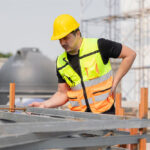
Construction work involves a range of risk factors that few other industries share. Workers are required to operate heavy equipment and vehicles, work from heights, perform regular manual handlining duties and face a variety of workplace hazards.
While all employers are obligated under UK law to protect the health and safety of their employees, construction-site managers, head contractors and supervisors must be especially diligent. By appointing a health and safety officer, employers can be sure that there is always a competent person on-site with the necessary skills, expertise, and experience to manage health and safety issues.
Safety officers play a key role in keeping construction-sites safe for both workers and members of the public. They work to assess, control, and eliminate on-site risks and ensure that all health and safety procedures and regulations are being followed correctly.
In this article, we will take a closer look at roles and responsibilities of safety officer in construction . We’ll also delve into current health and safety trends and concerns in the construction industry and provide useful links and information for anyone who wants to know how to become a health and safety officer in construction.
Safety Officer Roles in Construction
What does a construction safety officer do? And what is the role and responsibilities of safety officer? While every workplace is different, there are several roles and responsibilities of safety officer that are common to every construction-site.
These duties include:
Risk Assessments and Site Inspections
The health and safety officer on a construction-site is expected to perform regular inspections and assessments to identify and evaluate potential on-site hazards. They must then work to eliminate these risks and implement health and safety policies and procedures that protect workers from harm.
Compliance Monitoring
Health and safety officers are required to make sure that both supervisors and workers are adhering to all relevant health and safety regulations, policies and procedures. A health and safety officer must also check that the suppliers of any materials or equipment are complying with relevant legislation.
Accidents & Incident Investigation
If an accident or a near-miss incident occurs, the health and safety officer must conduct a thorough investigation. The investigation should establish the cause of the incident or accident and uncover evidence of any faults with equipment, compliance breaches or procedural failures. The health and safety officer may have to conduct interviews with witnesses and (if possible) the victim or victims.
Once the investigation is complete, the officer should prepare a report and if required submit it to the relevant authorities. Data gained from the report should then be used to enhance health and safety procedures to avoid future accidents or near-misses.
Record Keeping and Reporting
One of the main duties of a safety officer in a construction-site is to maintain accurate records of all risk assessments, site inspections, investigations and compliance breaches. When required, the health and safety officer must prepare and submit reports to authorities such as the newly created Building Safety Regulator (BSR).
Organising Health & Safety Training
To ensure the health and safety of employees and maintain compliance with regulations, the health and safety officer should arrange for staff at all levels to receive the appropriate, accredited health and safety training. This training can encompass on-site training as well as online health and safety training.
Because of the diverse number of tasks continuously being performed on any construction-site, health and safety officers must be sure that they also stay up to date with all relevant standards and government regulations. To keep their expertise current, health and safety officers should make certain they are aware of any changes to relevant legislation and regularly undertake refresher training courses.
What are the Growing Concerns for Safety in Construction?
The construction industry is one of the biggest sectors in the UK economy. Around 3.1 million people are employed in construction-related jobs, which is 9% of the overall UK workforce, according to recent government figures. The construction industry is also a major driver of the economy, contributing over 6% to the UK’s gross domestic product (GDP).
Alongside its size, the construction industry is also one of the most dangerous industries to work in. Just under 40 construction workers were fatally injured, with 61,000 workers reporting non-fatal injuries and 74,00 workers reporting health conditions related to their duties, as the latest statistics from the Health and Safety Executive (HSE) show.
Most Common Hazards
The highest number of fatal injuries were the result of falling from a height. The largest number of non-fatal injuries were caused by slips, trips, or falls. Ensuring that all workers have a stable and secure platform on which to perform their duties continues to be the leading concern for health and safety officers in the construction industry.
The most common hazards construction workers face include:
- Falls from a height
- Slips, trips, and falls
- Being struck or trapped under moving objects
- Hand arm vibration syndrome
- Material and manual handling injuries
- Collapsing trenches
- Asbestos-related illnesses
- Electrical hazards
- Airborne materials and fibres
Safety Trends in Construction
To combat risks in the construction industry, health and safety officers are increasingly turning to new technology to make sites safer for workers. Coming safety trends in the construction industry look set to include wearable devices that can monitor a worker’s blood pressure, heart rate and oxygen levels to prevent fatigue or alert supervisors to accidents.
Wearable technology can also incorporate sensors to warn workers when they are at risk of falling or coming too close to machinery. Geo-location tracking can provide supervisors with real-time information on the locations of individual workers and enable faster response rates if an accident occurs.
Artificial intelligence (AI) software can now be used to provide video-based real-time object recognition to identify any potential on-site risks. Drones and automated robots can monitor building sites to provide health and safety officers with continuous information on any developing hazards or alert them to an incident.
E-Checklists are also becoming much more popular on sites. These facilitate record keeping and ensure best practice is followed and training is implemented on the job.
Construction Safety Officer Training
If you are a health and safety officer or are considering becoming one there are numerous pathways out there to help you build upon your skill set. You do not need a degree to be a health and safety officer. However, you will need the experience, skills and training to ensure you can adequately do the job.
Many work their way up into the role building adequate skills over time, whilst working in the industry. This can be further facilitated by training courses such as IOSH Safety, Health & Environment for Construction Site Managers or some of the more in depth courses offered by the National Examination Board in Occupational Safety and Health (NEBOSH) .
There are also shorter courses to help you build your knowledge of the everyday hazards and tasks you will need to undertake as a health and safety courses.
Human Focus offers the following online health and safety training courses that are relevant to anyone working in construction:




















































































































































































































































































































































































































































































































































































































































































































































